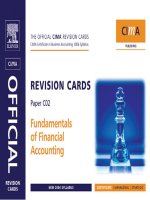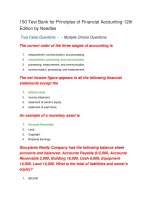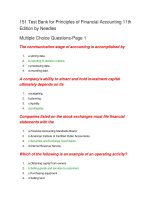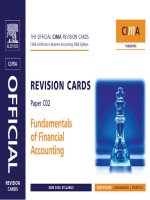Principles of financial accounting 12e by needles crosson chapter 06 sup
Bạn đang xem bản rút gọn của tài liệu. Xem và tải ngay bản đầy đủ của tài liệu tại đây (246.27 KB, 20 trang )
C HAP TE R
6
Supplement:
Special-Purpose Journals
Principles of
Accounting
12e
Needles
Powers
Crosson
© human/iStockphoto
Special-Purpose Journals
(slide 1 of 2)
Special-purpose journals promote
efficiency, economy, and control.
– They greatly reduce the work involved in
entering and posting transactions in the general
ledger, since only the total amounts of the
transactions are posted.
– Each journal can be assigned to a different
employee, which helps establish good internal
control.
Most business transactions fall into one of
four categories. Each kind of transaction can
be recorded in a special-purpose journal.
©2014 Cengage Learning. All Rights Reserved. May not be scanned, copied or duplicated, or posted to a publicly accessible website, in whole or in part.
Special-Purpose Journals
(slide 2 of 2)
The general journal is used to record
transactions, like purchase returns,
sales returns, and adjusting and closing
entries, that do not fall into any of
these special categories.
– When transactions are posted from the
general journal to the ledger accounts, the
posting abbreviation is J.
©2014 Cengage Learning. All Rights Reserved. May not be scanned, copied or duplicated, or posted to a publicly accessible website, in whole or in part.
Sales Journal
The sales journal is designed to handle
all credit sales. (Cash sales are recorded
in the cash receipts journal.)
The sales journal saves time because:
– Only one line is needed to record each
transaction. The credit to Sales is understood.
– No explanations are necessary because the
sales journal records only credit sales.
– Only one amount—the total credit sales—has
to be posted: once as a debit to Accounts
Receivable and once as a credit to Sales.
©2014 Cengage Learning. All Rights Reserved. May not be scanned, copied or duplicated, or posted to a publicly accessible website, in whole or in part.
Controlling Accounts and Subsidiary Ledgers
A controlling account (or control account)
is an account in the general ledger that
maintains the total of the individual account
balances in a subsidiary ledger.
A subsidiary ledger is a ledger separate
from the general ledger that contains a
group of related accounts, such as a list of
customers (accounts receivable subsidiary
ledger).
– The total of the balances in the group of related
accounts equals the balance in the corresponding
controlling account, such as Accounts Receivable.
©2014 Cengage Learning. All Rights Reserved. May not be scanned, copied or duplicated, or posted to a publicly accessible website, in whole or in part.
Summary of the Sales Journal Procedure
(slide 1 of 2)
Using a sales journal involves the following
steps:
– Step 1: Enter each sales invoice in the sales journal
on a single line. Record the date, the customer’s
name, the invoice number, and the amount.
– Step 2: At the end of each day, post each individual
sale to the customer’s account in the accounts
receivable subsidiary ledger. Place a check mark
(or customer account number) in the Post. Ref.
column of the sales journal. In the Post. Ref. column
of each customer’s account, place an S and the
sales journal page number to indicate the source of
the entry.
©2014 Cengage Learning. All Rights Reserved. May not be scanned, copied or duplicated, or posted to a publicly accessible website, in whole or in part.
Summary of the Sales Journal Procedure
(slide 2 of 2)
– Step 3: At the end of the month, sum the Amount
column in the sales journal to determine the total
credit sales, and post the total to the general
ledger accounts (Accounts Receivable and Sales).
Place the numbers of the accounts debited and
credited beneath the total in the sales journal to
indicate that this step has been completed. In the
general ledger, indicate the source of the entry in
the Post. Ref. column of each account.
– Step 4: Verify the accuracy of the posting by
adding the account balances of the accounts
receivable subsidiary ledger and comparing the
total with the balance of the Accounts Receivable
controlling account in the general ledger.
©2014 Cengage Learning. All Rights Reserved. May not be scanned, copied or duplicated, or posted to a publicly accessible website, in whole or in part.
Sales Taxes
Many cities and states require retailers
to collect a sales tax from their
customers and periodically remit the
total collected to the city or state.
– In this case, an additional column is needed
in the sales journal to record the credit to
Sales Taxes Payable on credit sales.
©2014 Cengage Learning. All Rights Reserved. May not be scanned, copied or duplicated, or posted to a publicly accessible website, in whole or in part.
Purchases Journal
The Purchases Journal is used to record
purchases on credit.
– It can take the form of either a single-column
journal or a multicolumn journal. In the singlecolumn journal, only credit purchases of
merchandise for resale to customers are
recorded.
– This kind of transaction is recorded with a debit
to Purchases and a credit to Accounts Payable.
– The Accounts Payable account is generally used
as a controlling account.
– A separate account for each supplier is kept in
an accounts payable subsidiary ledger.
©2014 Cengage Learning. All Rights Reserved. May not be scanned, copied or duplicated, or posted to a publicly accessible website, in whole or in part.
Summary of the Purchases Journal Procedure
(slide 1 of 2)
The procedure for using the purchases journal
is much like that for using the sales journal:
– Step 1: Enter each purchase invoice in the
purchases journal on a single line. Record the
date, the supplier’s name, the invoice date, the
terms (if given), and the amount.
– Step 2: At the end of each day, post each
individual purchase to the supplier’s account in the
accounts payable subsidiary ledger. Place a check
mark in the Post. Ref. column of the purchases
journal. Place a P and the page number of the
purchases journal in the Post. Ref. column of each
supplier’s account.
©2014 Cengage Learning. All Rights Reserved. May not be scanned, copied or duplicated, or posted to a publicly accessible website, in whole or in part.
Summary of the Purchases Journal Procedure
(slide 2 of 2)
– Step 3: At the end of the month, sum the Amount
column in the purchases journal, and post the
total to the general ledger as a debit to Purchases
and a credit to Accounts Payable. Place the
numbers of the accounts debited and credited
beneath the totals in the purchases journal to
show that this step has been carried out. In the
general ledger, indicate the source of the entry in
the Post. Ref. column of each account.
– Step 4: Check the accuracy of the posting by
adding the account balances of the accounts
payable subsidiary ledger and comparing the total
with the balance of the Accounts Payable
controlling account in the general ledger.
©2014 Cengage Learning. All Rights Reserved. May not be scanned, copied or duplicated, or posted to a publicly accessible website, in whole or in part.
Multicolumn Purchases Journal
The single-column purchases journal can be
expanded to record credit purchases of items
other than merchandise by adding separate
debit columns for other accounts that are used
often.
The individual transactions in the Accounts
Payable column are posted daily to the accounts
payable subsidiary ledger, and the totals of
each column in the purchases journal are
posted monthly to the corresponding general
ledger accounts. Entries in the Other Accounts
column are posted individually to the named
accounts.
©2014 Cengage Learning. All Rights Reserved. May not be scanned, copied or duplicated, or posted to a publicly accessible website, in whole or in part.
Cash Receipts Journal
All transactions involving receipts of cash
are recorded in the cash receipts journal.
– Although all cash receipts require a debit to
Cash, they differ in that they require a variety of
credit entries. Thus, the cash receipts journal
must have several columns.
– The Other Accounts column is used to record
credits to accounts not specifically represented
by a column. The account numbers are entered
in the Post. Ref. column, and the amounts are
posted daily to the appropriate account in the
general ledger. The Other Accounts column
totals are not posted at the end of the month.
©2014 Cengage Learning. All Rights Reserved. May not be scanned, copied or duplicated, or posted to a publicly accessible website, in whole or in part.
Cash Receipts Journal
The cash receipts journal has the following
debit and credit columns:
– Debit columns
Cash
Sales Discounts
Other Accounts—used for transactions that involve
debits both to Cash and to some account other than
Sales Discounts
– Credit columns
Accounts Receivable—used to record collections on
account from customers
Sales—used to record all cash sales
Other Accounts—used for any entry that is neither a
cash collection from accounts receivable nor a cash sale
©2014 Cengage Learning. All Rights Reserved. May not be scanned, copied or duplicated, or posted to a publicly accessible website, in whole or in part.
Summary of the Cash Receipts
Journal Procedure (slide 1 of 2)
The procedure for posting the cash receipts
journal follows:
– Step 1: Post the transactions in the Accounts
Receivable column daily to the accounts receivable
subsidiary ledger. Place a check mark in the Post.
Ref. column of the cash receipts journal and CR plus
the page number in the Post. Ref. column of each
subsidiary ledger account.
– Step 2: Post the debits/credits in the Other Accounts
columns to the general ledger accounts. Write the
account number in the Post. Ref. column of the cash
receipts journal and CR plus the page number in the
Post Ref. column of the general ledger account.
©2014 Cengage Learning. All Rights Reserved. May not be scanned, copied or duplicated, or posted to a publicly accessible website, in whole or in part.
Summary of the Cash Receipts
Journal Procedure (slide 2 of 2)
– Step 3: At the end of the month, total the columns in
the cash receipts journal. The sum of the Debits
column totals must equal the sum of the Credits
column totals.
– Step 4: Post the Debits column totals to the
corresponding accounts in the general ledger.
– Step 5: Post the Credits column totals to the
corresponding accounts in the general ledger.
– Steps 6-7: Write the account numbers below each
column in the cash receipts journal and CR plus the
page number in the Post. Ref. column of each
account in the general ledger. Place a check mark at
the bottom of the Other Accounts column, which was
already posted in Step 2.
©2014 Cengage Learning. All Rights Reserved. May not be scanned, copied or duplicated, or posted to a publicly accessible website, in whole or in part.
Cash Payments Journal
All transactions involving payments of
cash are recorded in the cash payments
journal (or cash disbursements journal).
The cash payments journal includes the
following credit and debit columns:
– Credit columns: Cash, Purchases Discounts,
Other Accounts
– Debit columns: Accounts Payable, specific
expense accounts (such as Salary Expense,
Advertising Expense, and Rent Expense),
Other Accounts
©2014 Cengage Learning. All Rights Reserved. May not be scanned, copied or duplicated, or posted to a publicly accessible website, in whole or in part.
Summary of the Cash Payments
Journal Procedure (slide 1 of 2)
The procedure for posting the cash
payments journal follows:
– Step 1: Post the transactions in the Accounts
Payable columns daily to the individual
accounts in the accounts payable subsidiary
ledger. Place a check mark in the Post. Ref.
column of the cash payments journal.
– Step 2: Post the debits/credits in the Other
Accounts debit/credit columns to the general
ledger. Write the account number in the Post.
Ref. column of the cash payments journal and
CP plus the page number in the Post. Ref.
column of each general ledger account.
©2014 Cengage Learning. All Rights Reserved. May not be scanned, copied or duplicated, or posted to a publicly accessible website, in whole or in part.
Summary of the Cash Payments
Journal Procedure (slide 2 of 2)
– Step 3: At the end of the month, the columns are
footed and crossfooted. That is, the sum of the
Credits column totals must equal the sum of the
Debits column totals.
– Step 4: At the end of the month, post the column
totals for Cash, Purchases Discounts, Accounts
Payable, and the expense accounts to their
respective accounts in the general ledger. Write the
account number below each column in the cash
payments journal and CP plus the page number in the
Post. Ref. column of each general ledger account.
Place a check mark under the total of each Other
Accounts column in the cash payments journal to
indicate that the postings in that column have been
made.
©2014 Cengage Learning. All Rights Reserved. May not be scanned, copied or duplicated, or posted to a publicly accessible website, in whole or in part.
General Journal
Adjusting and closing entries, as well as
transactions that do not involve sales,
purchases, cash receipts, or cash
payments, are recorded in the general
journal.
When a debit or credit is made to a
controlling account, the entry must be
posted twice, once to the controlling
account and once to the individual
account in the subsidiary ledger.
©2014 Cengage Learning. All Rights Reserved. May not be scanned, copied or duplicated, or posted to a publicly accessible website, in whole or in part.









